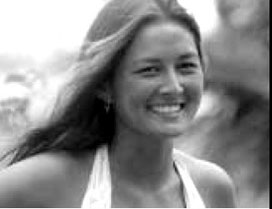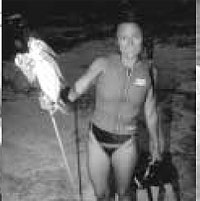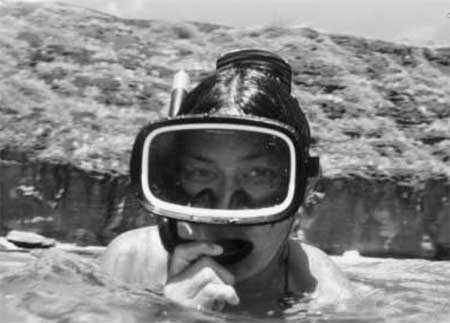 A
TRIBUTE TO RELL SUNN, QUEEN OF MAKAHA
A
TRIBUTE TO RELL SUNN, QUEEN OF MAKAHA
by Naomi Sodetani
Photos of courtesy of Jeff Divine
Growing
up in Makaha, the late pioneer surfer Rell Kapolioka`ehukai (Heart
of the Sea) Sunn slept not with dolls but with her surfboards.
“Before I could read words, I could read the ocean, I could
read the tides, the wind on the ocean,” she recalled. “I
thought I knew everything I ever needed to know just from being
on the beach. Everything. ”That knowledge nurtured the Native
Hawaiian water woman throughout her life. It gave her a competitive
edge during her vibrant professional surfing career, then offered
healing refuge in a 15-year battle against cancer that finally claimed
her in the prime of her life.
A
two-and-a-half hour interview with Sunn, videotaped just two months
before her death, provides the poignant, compelling pulse of “Heart
of the Sea,” the first documentary to chronicle the life of
the beloved local legend. The film is sprinkled with commentary
by those close to her and reflects the love and admiration everyone
shared for Sunn.
Dalani
Kauhiou, who wrote an article on women’s surfing for H3O magazine
in the 80s, was one of many inspired by Sunn and the pack of women
surfers she met down at Makaha Beach. “We paddled together
and they invited me to surf with them. What impressed me is that
they were all working mothers, just like me, with a desire to see
women’s surfing recognized.” She even recalls how women’s
surf shorts were not being made at the time, despite many requests.
Kauhiou
shares, ”Rell was the most beautiful thing to watch in the
water. She always made it look so easy and graceful.At first I thought,
‘there must be some mechanics to it!’
”Sunn
cherished the ocean as a benevolent realm where her `aumakua, ancestor
gods, lived. “All our forefathers, all our uncles and anyone
who had passed away were in the ocean, so there was nothing to fear,”
Sunn explained.
Kathy
Terada, a close friend of Sunn,offers vivid details that illuminate
Sunn’passion for the sea. “I remember the marks of her
dive mask always on her face,” and how she “had to sleep
with Vaseline on her hands and feet, because they were so cracked
from all those hours in the water.” And when surf wa sup,
Terada chuckles, Sunn would take15-minute breaks to catch a few
waves during hula practice.
Sunn’s
daughter Jan Sunn-Carreira tells how her mother struggled to balance
her dreams with the burdens of being a sole provider. While surfing
competitively,Sunn worked as a lifeguard and rotated stints as a
KCCN disc jockey and surf reporter to pay the bills.
Sunn-Carreira
recalls how her mother always kept her best interests in mind.“Whether
it was sending me toKamehameha Schools or putting me in piano lessons,
she was always looking out for me, finding ways to teach me lessons.”
Sunn-Carreira, who now has a17-month old daughter, Kamalani, realizes
the value of those lessons as she raises her own daughter.“
She
was everything for me: my mother,my father, my sister, my brother.
Looking back, she was the whole package,”shares Sunn-Carreira.
“What’s neat is seeing her in my daughter, Kamalani.
Certain facial expressions or personality traits reflect my mother
and we just have to smile.
”In
1982, Sunn felt a lump in her breast while toweling off. She was
32, in great physical shape, and at the top of her game as the top-ranked
woman on thelongboard.
“Sometimes
things happen in our lives. You just might hit a wall,” Sunn
stated simply. “Mine was cancer.” Her eyes and smile
radiate good humor as she reflects on her life and impending death
without a whit of self-pity. The film traces Sunn’s wrenching
15-yearordeal through hospital wards as she underwent radiation,
bone marrow replacements and chemotherapy that made her scream in
pain. Many times she fought the disease into remission, but it recurred,
spreading through her body and, finally, her brain.“You realize
the life you lived, free-spirited, doesn’t belong to you.
It belongs to the pain in your back, your lungs, your skin,”
Sunn said. “But when you get in the water, you own your life
again. It’s wonderful.
”Sunn
truly believed that the ocean that fed her soul sustained her life
and was convinced of the healing power of kapukai, the ancient ritual
of going into the water to cleanse and purify oneself .“Rell
loved life so much and she persevered through everything. To me,
she was grace under pressure.’ When the wave takes you under
and turns you overhand over, you either drown or you swim to the
surface, take a breath and go backhand do it again. Rell kept going
back for more. Her love for life, for people, and her intimacy with
the ocean kept her alive,” shares Kauhiou.
In
the ‘60s, the Makaha International descended on Sunn’s
tiny hometown and the teen observed bold, bronzed men with foreign
accents trading tales of their globe-trotting surf adventures. “I
swore then that women could tell these same wonderful stories, and I would live that life that they lived,” Sunn
recalled.
stories, and I would live that life that they lived,” Sunn
recalled.
In the early ‘70s, Sunn was instrumental in founding the Women’s
Professional Surfing Association and the first professional tour
for women. Fondly dubbed the“Queen of Makaha,” Sunn
preside over her favorite beach as Hawaii’s first female lifeguard.
Vibrant and charismatic, she also won the hearts of many around
the world as an ambassador of aloha by encouraging thousands of
children to surf and helping other women stricken with cancer.
Sunn
twice finished third in international year-end rankings of the tour
she helped establish, and received the Waterman Achievement Award.
In 1996, she became one of the first five women inducted into the
Surfing Walk of Fame, her granite stone sharing the same patch of
sidewalk with that of Duke Kahanamoku, Native Hawaiian Olympian
gold medallist, the father of modern surfing and Sunn’s childhood
hero.
“Rell
embodied everything that is great about surfing, but she grew larger
than that,” says former surfing champion Fred Hemmings. “She
represented the values we hold so dear in Hawai`i. Rell was a giver,
not a taker.”In 1975 she founded the annual Rell Sunn Menehune
Surf Contest at Makaha, which over the years has given countless
local kids a venue to have fun and to excel. She even took a group
one year to compete in Biarritz, France. Kauhiou remembers the Easter
egg hunts Rell organized for the children of Makaha. “Every
year we’d bring eggs down to the beach and hide them everywhere.
All the kids in Makaha would come out to find them. Rell would give
away her old trophies and other surf gear as prizes. And she always
managed to get everyone involved in helping out.”
Sunn’s daughter also recalls
the annual event. “We would hide the eggs in the tide pools.
As the children got older, they would have to dive for them. It
was so much fun, everyone looked forward to Easter,” says
Sunn-Carreira. “I appreciated her ability to teach simple
lessons using our own backyard, the ocean.
”Sunn
was a role model and a teacher for the children of Makaha. “She
just wanted to instill in them an appreciation for the water. She
taught them lessons,showed them the tide pools, made them pick up
trash on the beach,” says Kauhiou. Sunn extended her aloha
to not only the children, but everyone she met.
In
her final years, Sunn volunteered as a Navigator for the Wai`anae
Cancer Research outreach program, sharing her experience to help
other Native Hawaiian women cope with the insidious disease.“The
aloha spirit is real simple,” Sunn often explained. “You
give and you give and you give... and you give from here (the heart),
until you have nothing else to give.
”All
that aloha came back to her in the end. When she lost her hair and
was forced to wear a swim cap, local surfers also donned caps in
camaraderie. When she became too weak to paddle, they’d push
her off to catch a wave. Numerous benefit concerts were organized
by those whose lives she touched to help pay her medical bills.
 When
Sunn died on January 2, 1998, at age 47, thousands of mourners packed
Makaha Beach to bid a final farewell. A convoy of surfers accompanied
her family’s canoe as they gently released a glass ball holding
her ashes, freeing her to roam the world again through its currents
and waves.
When
Sunn died on January 2, 1998, at age 47, thousands of mourners packed
Makaha Beach to bid a final farewell. A convoy of surfers accompanied
her family’s canoe as they gently released a glass ball holding
her ashes, freeing her to roam the world again through its currents
and waves.
Co-directed
by California film makers Charlotte Lagarde and Lisa Denker, with
guidance provided by Academy Award-nominated Executive Producer
Janet Cole and award-winning editor Vivien Hillgrove, the film conveys
a keen, deeply-moving portrait of a woman who blazed an unconventional
path and breached the predominantly male domain of professional
surfing, opening the way for other women.
The
film opens with a rush of churning waters and Sunn’s voice
recounting how her grandmother prophetically named her at birth.
Taught by her beachboy father, she excelled in swimming, surfing,
canoe-paddling, diving and spear-fishing. Lustrous black and white
“flashback” scenes show Sunn paddling and surfing as
a little girl (portrayed by M -akaha resi-dent Desiree DeSoto).
“It was essential to recreate a sense of Rell’s world,”
says producer/director Lagarde. “To draw viewers into her
ocean environment.
”Lagarde’s
prior films include “Swell,”which portrays four generations
of women surfers, and “Zeuf,” about a woman surfer’s
struggle with breast cancer. It was Zeuf who first told Lagarde
that Sunn was her role model, after which the filmmaker kept bumping
into people “who’d tell me their Rell stories.”Originally
conceived as a history of women’s surfing, the documentary
“Heart of the Sea” eventually focused on the surfing
champion. Lagarde and Denker spent 10 days with Sunn in M -akaha
in October 1997.Though so weak she could hardly breathe, she showed
them her favorite tide pools, surf and diving spots, and introduced
them to her inner circle of friends. After she died two months later,
her friends “opened M -akaha to us,” says Lagarde.
“Rell orchestrated this film,” Lagarde says. “She
really wanted it to focus on her life, not her end. ”Archival
television footage follows Sunn’s public exploits as a pro
surfer and local celebrity, while Sunn and those closest to her
refract her personal journey through the intimate lens of private
moments shared. Pacific Islanders In Communications supported the
project early on with a production grant. But few other funders
outside the Islands knew who Rell Sunn was or grasped the value
of her story. Lagarde shakes her head: “They kept asking,
‘Is it a surf movie or a cancer movie?’
”Ultimately,
the filmmakers obtained sufficient funding to edit the film from
the Corporation for Public Broadcasting and the Independent Television
Service, the latter linked to KHET’s participation.“Heart
of the Sea” will be broadcast May 6 on the PBS series Independent
Lens at 10:00 p.m.The filmmakers held their breaths whent hey shipped
a fine cut to Sunn’s family.“They’re your most
critical audience,”Lagarde says. “When they called to
say they liked it, we went, ‘OK, we got it, whew!
’”Fittingly,
“Heart of the Sea” ends with the lyrical underwater
image of a lonehonu haloed by sun rays as it hovers at the cusp
of the two worlds that Sunn inhabited. The viewer is left sensing
that Sunn’s spirit has simply rejoined her ancestors
.“Heart
of the Sea” pays tribute to a life joyfully and gracefully
lived for all its trials, and offers a lesson to us all. “Live
for now, value the present and let there be no regrets,” says
daughter Sunn-Carreira.
“Rell
is the great reminder to do what you love,” Lagarde says.
“She touched so many people’s lives just being herself.
She was an amazing surfer, but it’s her incredible spirit
and her smile that people always remember.”
top of page
home



